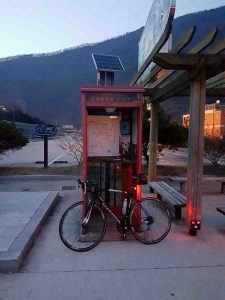Buljeong Station
Buljeong Station (불정역; map) is a retired rail stop on the defunct Mungyeong Line (문경선) a few hundred meters east of the Jinnamgyoban Area in Mungyeong City (문경시; map).

Buljeong Station (불정역; map) is a retired rail stop on the defunct Mungyeong Line (문경선) a few hundred meters east of the Jinnamgyoban Area in Mungyeong City (문경시; map).
Built in 1954, workers assembled Buljeong Station from stones fetched from the nearby Yeong River (영강; map), giving its main building a rustic cabin form.
In its heyday, Buljeong Station’s main customers weren’t people. The station loaded 4,500 tons of coal per day, dug from nearby mountains onto train carriages, powering Korea’s development after the Korean War.

When Buljeong Station closed in 1993, Mungyeong City tried a few schemes to keep the station active.
- The city designated the station a “Registered Cultural Property” in 2007.
- They transformed retired train cars on the station’s tracks into a pension (vacation home).
- Mungyeong Railbike (문경철로자전거; map) used Buljeong Station as its last stop for its pedal-powered train cars.
- In 2011, the Saejae Bike Path added the Mungyeong Buljeong Station Certification Center (문경불정역 인증센터; map) in the station’s courtyard. (Stamp your Bike Passport here.)
Because of Buljeong Station’s remote location, both the pension and railbike section closed in the mid-2010s.
Opened in 2017, the Arario Doll Opera House (아라리오인형 오페라하우스; map) now occupies Buljeong Station’s main building.









